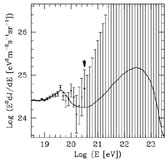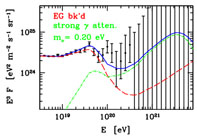


2.3. Metastable Superheavy Relics?
As was discussed by several speakers at this meeting, there may well exist ultra-high-energy cosmic rays (UHECR) beyond the Greisen-Zatsepin-Kuzmin (GZK) cutoff, that is expected due to interactions with the CMB [88]. The experimental situation is not yet clear, since there are issues of energy calibration and flux normalization between the two experiments with the highest statistics, AGASA and Hi-Res. Experiments at CERN might be able to help by updating studies of fluoresecence due to particles passing through Nitrogen, and by validating models of high-energy particle interactions at the LHC.
Assuming that UHECR beyond the GZK cutoff do exist, there are two main scenarios for their origins: bottom-up mechanisms involving discrete sources within the GZK range, and top-down mechanisms that invoke the decays of ultra-massive particles or topological defects [89].
Bottom-up mechanisms are clearly more conservative (and hence more plausible?). They suggest that the observed UHECR should cluster and perhaps align with sources observable by other means, such as active galactic nuclei or gamma-ray bursters, unless intergalactic magnetic fields are strong enough to spread them out. There have indeed been reports of clustering and possible alignment, but these have yet to attain consensus.
It has been realized that the gravitational production of superheavy
unstable relics, cryptons, is likely to be efficient enough to
provide an interesting relic density. Moreover, the hidden sectors of
string models generically contain such particles, which naturally have
long lifetimes, thanks to selection rules and because interactions between
the hidden and observable sectors are usually of very high order and very
weak. As we heard at this meeting
[90],
the crypton decay spectrum may fit well
the apparent excess of UHECR beyond the GZK cutoff. However, models tend
to predict a large
 / proton
ratio, whereas the observed UHECR have
been consistent with protons and could not all be photons. In any crypton
model, most of the UHECR would originate from decays within the halo of
the Milky Way. This means that their arrival directions should exhibit a
galactic anisotropy, and could also cluster if much of the halo consists
of clumped cold dark matter.
/ proton
ratio, whereas the observed UHECR have
been consistent with protons and could not all be photons. In any crypton
model, most of the UHECR would originate from decays within the halo of
the Milky Way. This means that their arrival directions should exhibit a
galactic anisotropy, and could also cluster if much of the halo consists
of clumped cold dark matter.
A third scenario discussed at this meeting is the Z-burst model, according to which the UHECR observed originate from collision between primary UHE neutrinos that strike relic dark matter neutrinos to produce Z0 bosons that subsequently decay. This scenario requires relic neutrinos that are somewhat heavier than one might expect on the basis of atmospheric and solar oscillation experiments, but the hypothesis cannot be excluded at present, as seen for example in Fig. 16 [90].

|

|
Figure 16. Illustrations of fits to the UHECR data in the crypton decay (upper) and Z-burst (lower) models [90]. |
As we heard at this meeting, a series of ambitious experiments on UHECR are now being prepared or planned. The Auger experiment currently being constructed in Argentina will combine fluorescence and calorimetric techniques, and have a much larger surface area than previous experiments [91]. EUSO [92] and OWL-Airwatch are proposals for space experiments to look down at fluorescence in the atmosphere over much larger areas still. The physics issues concerning UHECR are on their way to being resolved.